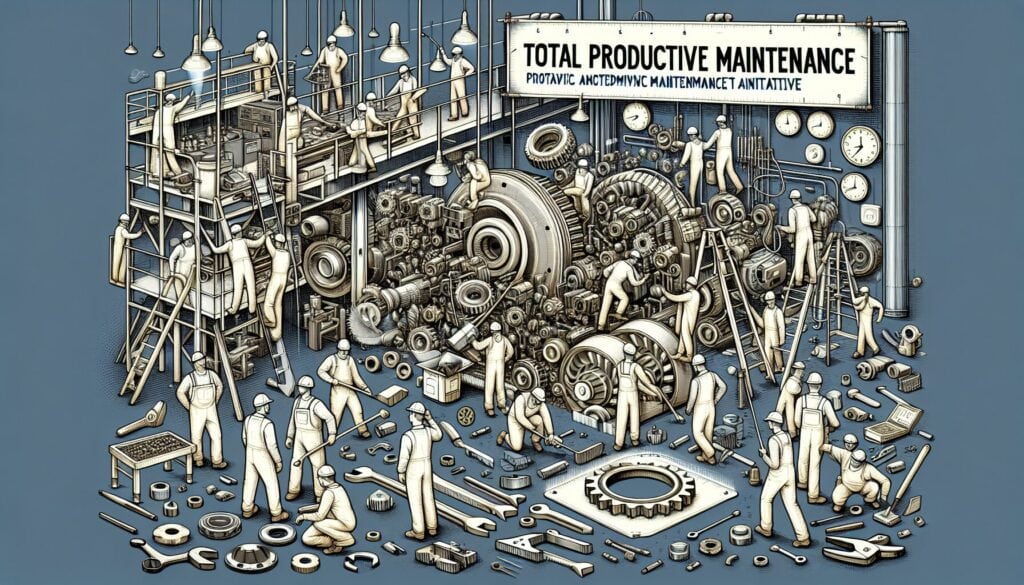通过让所有员工都参与到设备维护中来的积极主动的整体方法,实现近乎完美的生产(无故障、无小停机或运行缓慢、无缺陷、无事故)。
- 方法: 工程, 质量
全面生产维护(TPM)

全面生产维护(TPM)
- 持续改进, 精益制造, 精益生产, 维护, 整体设备效率 (OEE), 流程改进, 生产率, 质量管理, 安全
目标
如何使用
- 通过机器、设备、流程和员工来维护和改进生产和质量系统完整性的系统,从而为企业增加商业价值。它强调授权操作员帮助维护设备(自主维护)。
优点
- 提高设备效率(OEE)和可靠性;减少停机时间和维护成本;改善安全性和产品质量;提高员工参与度和士气。
缺点
- 需要重大的文化转变和长期承诺;全面实施可能成本高昂,耗时长;需要对操作人员和维护人员进行广泛培训。
类别
- 工程, 人力资源, 精益西格玛, 制造业, 质量
最适合:
- 最大限度地提高设备效率和 寿命 通过全面、主动的维护战略,让所有员工都参与进来。
全面生产维护(TPM)广泛应用于各行各业,尤其是制造业、汽车业和食品加工业,这些行业的设备正常运行时间对于保持生产效率和质量至关重要。在项目阶段,TPM 可以在设计和开发阶段进行整合,操作人员的意见可以使设备设计更具可维护性,从而提高运行性能。它通常涉及跨职能团队,其中包括维护人员、生产人员和质量控制专家,他们共同合作确定需要改进的地方并实施预防措施。由管理层发起的 TPM 有赖于所有员工的参与,鼓励他们以主人翁的态度对待自己操作的机器,从而建立起一种持续改进和解决问题的文化。例如,在汽车行业,采用 TPM 原则已经 引领 TPM 可显著减少设备故障和计划外停机时间,使公司能够通过密切监控性能指标和做出以数据为导向的决策来提高设备综合效率 (OEE)。参与 TPM 计划的员工也表示工作满意度和主人翁意识得到提高,从而提升了士气和生产率。这种方法不仅针对维护任务,还注重采用整体方法来提高流程能力,确保企业能够快速适应需求或生产方法的变化,同时保持较高的安全和质量标准。
该方法的关键步骤
- 进行初步设备评估,以确定当前状况和维护需求。
- 通过培训操作员执行例行检查和小型维修,实施自主维护。
- 为预防性和预测性维护任务制定定期维护计划。
- 规范操作程序,确保性能一致,减少变异。
- 将 TPM 原则纳入日常工作流程,以实现持续改进。
- 对故障进行根本原因分析,并实施纠正措施,防止故障再次发生。
- 让所有员工都参与到 TPM 活动中来,培养共同承担责任的文化。
- 利用可视化管理工具跟踪维护进度和设备状态。
专业提示
- 为操作员实施结构化培训计划,以识别设备问题的早期迹象,加强早期干预和预防措施。
- 利用数据分析进行实时监控,实现预测性维护和优化调度,最大限度地减少中断。
- 鼓励跨职能团队评估和分析设备性能,确保为持续改进提供多样化的意见和创新解决方案。
历史背景
1962
1970
1972
1980
1980
1986
1986
1960
1963
1970
1980
1980
1980
1986
1987
(如果日期不详或不相关,例如 "流体力学",则对其显著出现的时间作了四舍五入的估计)。















相关文章
蒙特卡罗模拟
基于模型的测试
型号检查
混合方法研究
防错(Poka-Yoke)
任务简介测试